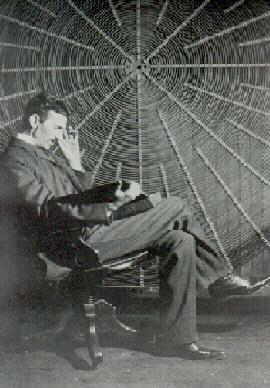Biography of worlds greatest scientist Nikola Tesla
Nikola Tesla was born on July 10, 1856 in Smiljan, Lika, which was then part of the Austro-Hungarian Empire, region of Croatia. His father, Milutin Tesla was a Serbian Orthodox Priest and his mother Djuka Mandic was an inventor in her own right of household appliances.
In 1883, he privately built a prototype of the induction motor and ran it successfully.
His childhood dream was to come to America to harness the power of Niagara Falls.
In February 1882, Tesla discovered the rotating magnetic field, a fundamental principle in physics and the basis of nearly all devices that use alternating current.
Tesla astonished the world by demonstrating. the wonders of alternating current electricity at the World Columbian Exposition in Chicago in 1893. Alternating current became standard power in the 20th Century. This accomplishment changed the world. He designed the first hydroelectric power plant in Niagara Falls in 1895, which was the final victory of alternating current.
The Tesla coil, which he invented in 1891, is widely used today in radio and television sets and other electronic equipment.
Tesla is the father of the radio and the modern electrical transmissions systems. He registered over 700 patents worldwide. His vision included exploration of solar energy and the power of the sea. He foresaw interplanetary communications and satellites.
The Electrical Review in 1896 published X-rays of a man, made by Tesla, with X-ray tubes of his own design. They appeared at the same time as when Roentgen announced his discovery of X-rays. Tesla never attempted to proclaim priority. Roentgen congratulated Tesla on his sophisticated X-ray pictures, and Tesla even wrote Roentgen's name on one of his films. He experimented with shadowgraphs similar to those that later were to be used by Wilhelm Rontgen when he discovered X-rays in 1895.
In 1896 Tesla constructed an instrument to receive radio waves. He experimented with this device and transmitted radio waves from his laboratory on South 5th Avenue. to the Gerlach Hotel at 27th Street in Manhattan. The device had a magnet which gave off intense magnetic fields up to 20,000 lines per centimeter. The radio device clearly establishes his priority in the discovery of radio.
The heart of radio transmission is based upon four tuned circuits for transmitting and receiving. It is Tesla's original concept demonstrated in his famous lecture at the Franklin Institute in Philadelphia in 1893. The four circuits, used in two pairs, are still a fundamental part of all radio and television equipment.
The United States Supreme Court, in 1943 held Marconi's most important patent invalid, recognizing Tesla's more significant contribution as the inventor of radio technology.
Tesla built an experimental station in Colorado Springs, Colorado in 1899, to experiment with high voltage, high frequency electricity and other phenomena.
Tesla lectured to the scientific community on his inventions in New York, Philadelphia and St. Louis and before scientific organizations in both England and France in 1892. Tesla’s lectures and writings of the 1890s aroused wide admiration among contemporaries popularized his inventions and inspired untold numbers of younger men to enter the new field of radio and electrical science.
Nikola Tesla was one of the most celebrated personalities in the American press, in this century. According to Life Magazine's special issue of September, 1997, Tesla is among the 100 most famous people of the last 1,000 years. He is one of the great men who divert the stream of human history. Tesla's celebrity was in its height at the turn of the century. His discoveries, inventions and vision had widespread acceptance by the public, the scientific community and American press. Tesla's discoveries had extensive coverage in the scientific journals, the daily and weekly press as well as in the foremost literary and intellectual publications of the day. He was the Super Star.
In 1894, he was given honorary doctoral degrees by Columbia and Yale University and the Elliot Cresson medal by the Franklin Institute. In 1934, the city of Philadelphia awarded him the John Scott medal for his polyphase power system. He was an honorary member of the National Electric Light Association and a fellow of the American Association for the Advancement of Science. On one occasion, he turned down an invitation from Kaiser Wilhelm II to come to Germany to demonstrate his experiments and to receive a high decoration.
In 1915, a New York Times article announced that Tesla and Edison were to share the Nobel Prize for physics. Oddly, neither man received the prize, the reason being unclear. It was rumored that Tesla refused the prize because he would not share with Edison, and because Marconi had already received his.
On his 75th birthday in 1931, the inventor appeared on the cover of Time Magazine. On this occasion, Tesla received congratulatory letters from more than 70 pioneers in science and engineering including Albert Einstein. These letters were mounted and presented to Tesla in the form of a testimonial volume.
Tesla died on January 7th, 1943 in the Hotel New Yorker, where he had lived for the last ten years of his life. Room 3327 on the 33rd floor is the two-room suites he occupied.
Hi! I am a robot. I just upvoted you! I found similar content that readers might be interested in:
http://teslasociety.com/biography.htm
thanks, keep upvoting
GOOD WORK
goods
nice work
nice post
nice post
great information x-ray invented by tesla i know that 1st time
thanks for the information
You are welcomed
:-)
grt
nice
Nice Work bro